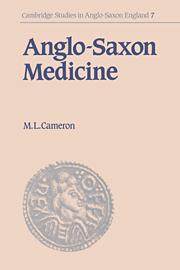Book contents
- Frontmatter
- Contents
- Preface
- Acknowledgements
- List of abbreviations
- 1 Introduction
- 2 Conditions for health and disease
- 3 Physician and patient
- 4 The earliest notices of Anglo-Saxon medical practice
- 5 Medical texts of the Anglo-Saxons
- 6 Compilations in Old English
- 7 Compilations in Latin
- 8 Latin works translated into Old English: Herbarium and Peri Didaxeon
- 9 Sources for Old English texts
- 10 Making a Leechbook
- 11 Materia medica
- 12 Rational medicine
- 13 Magical medicine
- 14 The humours and bloodletting
- 15 Surgery
- 16 Gynaecology and obstetrics
- 17 Conclusions
- Appendix 1 Quotations for ch. 10
- Appendix 2 Quotations for ch. 13
- Appendix 3 Quotations for ch. 14
- Appendix 4 Quotation for ch. 15
- Bibliography
- Index
Appendix 3 - Quotations for ch. 14
Published online by Cambridge University Press: 30 September 2009
- Frontmatter
- Contents
- Preface
- Acknowledgements
- List of abbreviations
- 1 Introduction
- 2 Conditions for health and disease
- 3 Physician and patient
- 4 The earliest notices of Anglo-Saxon medical practice
- 5 Medical texts of the Anglo-Saxons
- 6 Compilations in Old English
- 7 Compilations in Latin
- 8 Latin works translated into Old English: Herbarium and Peri Didaxeon
- 9 Sources for Old English texts
- 10 Making a Leechbook
- 11 Materia medica
- 12 Rational medicine
- 13 Magical medicine
- 14 The humours and bloodletting
- 15 Surgery
- 16 Gynaecology and obstetrics
- 17 Conclusions
- Appendix 1 Quotations for ch. 10
- Appendix 2 Quotations for ch. 13
- Appendix 3 Quotations for ch. 14
- Appendix 4 Quotation for ch. 15
- Bibliography
- Index
Summary
3.1 Leechdoms, ed. Cockayne II, 146-8: ‘On hwilce tid blod sie to forganne, on hwilce to lætenne. Blodlæs is to forganne fiftyne nihtum ær Hlafmæsse 7 æfter fif 7 þritig nihtum, for þon þonne ealle æterno þing fleogaþ 7 mannum swiðe deriað. Læcas lærdon þa þe wisoste wæron þæt nan man on þam monþe ne drenc nedrunce ne ahwær his lichoman wanige butan his nydþearf wære; 7 þonne on middeldagum inne gewunode for þon þe sio lyft biþ þonne swist gemenged. Romane him forþon 7 ealle suð folc worhton eorþ hus for þære lyfte wylme 7 æternesse. Eac secgeað læcas þætte geblowene wyrta þonne sien betste to wyrcenne, ge to drencum ge to sealfum ge to duste.
‘Hu mon scule blodlæse on þara six fifa ælcum on monðe forgan 7 hwonne hit betst sie. Læcas lærað eac þæt nan man on þon fif nihta ealdne monan 7 eft. x. nihta 7 fiftyne 7 twentiges 7 fif 7 twentiges 7 þringes nihta ealdne monan ne læte blod ac betweox þara sex fifa ælcum, 7 nis nan blodlæstid swa god swa on foreweardne lencten þonne þa yfelan wætan beoþ gegaderode þe on wintra gedruncene beoð 7 on Kalendas Aprilis ealra selest, þonne treow 7 wyrta ærest up spryttað; þonne weaxeð sio yfele gillestre 7 þæty fele blod on þam holcum þæs lichoman.
‘Gif monnes blod dolh yfelige genim þonne geormen leaf, awylle on wætre 7 beþe mid, 7 gecnua nioþowearde, lege on.
- Type
- Chapter
- Information
- Anglo-Saxon Medicine , pp. 195 - 196Publisher: Cambridge University PressPrint publication year: 1993

